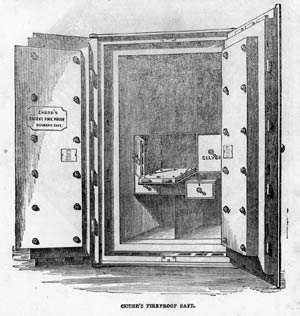|

NOTES ON ISSUE 7: HISTORICAL GLOSSARY
PART 2 OF 2
red
tape
Government papers and legal documents
were once bound with a reddish tape. Thomas Carlyle—to whom
Dickens dedicated Hard Times when it appeared in its
first volume edition—popularized the term to denote excessive
bureaucratic regulations.
"In the little safe in young Tom's
closet, the safe used for petty purposes, there was a hundred
and fifty odd pound." "A hundred and fifty-four, seven, one,"
said Bitzer.
Bitzer's clarification reveals that the
safe contained exactly 154 pounds, seven shillings, and a penny
before the robbery. Before the British monetary system was decimalized
in 1971, there were 20 shillings to the pound and twelve pence
to the shilling. It is difficult to make exact comparisons of
value between past and present currencies, as the factors that
affected cost of living were so different, but recall that Mrs.
Sparsit's annual salary was £100. Many male workers, with families,
made about £1 per week. Thus, £154, 7s., 1d. is
a relatively substantial sum.
The money would have been kept in a safe that might have looked
similar to this depiction of a patent fireproof safe made by
Chubb, a new design that was shown at the Great Exhibition of
1851. This illustration appeared in the Illustrated London
News on July 26, 1851; note the legend "Bankers Safe" on
the door.

Dutch clocks
Inexpensive German clocks, made in the
Black Forest region, were popular in middle- and lower-class
British homes. ("Dutch" was a corruption of "Deutsch.") They
made a loud sound before they struck the hour, which Mrs. Sparsit
refers to here. This picture of such a clock is taken from The
Dictionary of Daily Wants:

floor the Established Church
The Church of England was the state church
and was therefore referred to as the Established Church; Mr.
Bounderby implies that Stephen Blackpool, in seeking a divorce,
sought also to divorce church and state. As the nineteenth century
went on, the establishment of the Church became controversial.
Mr. Bounderby, like an Oriental
dancer, put his tambourine on his head.
Dancers in the Oriental style raised
up their tambourines to signify the end of a performance.
on the mangle in the laundry
A mangle was a hand-operated machine
used to dry and press items after washing. Mrs. Beeton's Book
of Household Management includes this illustration of a
mangle:

"not your sherry warm,
with lemon-peel and nutmeg"
This combination was a popular Victorian
drink, known as negus.
she arose, put on a loose robe,
and went out of her room in the dark and up the staircase to
her brother's room
Louisa and Bounderby apparently have
separate rooms. This was not uncommon for well-to-do Victorian
couples.
|

